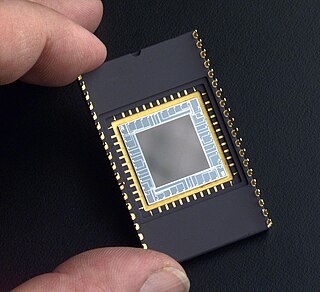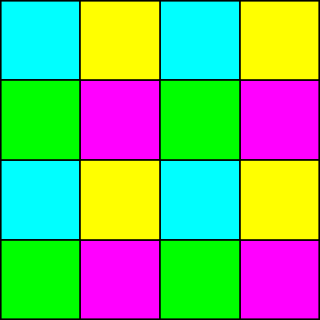
A charge-coupled device (CCD) is an integrated circuit containing an array of linked, or coupled, capacitors. Under the control of an external circuit, each capacitor can transfer its electric charge to a neighboring capacitor. CCD sensors are a major technology used in digital imaging.

In digital imaging, a pixel, pel, or picture element is the smallest addressable element in a raster image, or the smallest addressable element in a dot matrix display device. In most digital display devices, pixels are the smallest element that can be manipulated through software.

A digital camera, also called a digicam, is a camera that captures photographs in digital memory. Most cameras produced today are digital, largely replacing those that capture images on photographic film or film stock. Digital cameras are now widely incorporated into mobile devices like smartphones with the same or more capabilities and features of dedicated cameras. High-end, high-definition dedicated cameras are still commonly used by professionals and those who desire to take higher-quality photographs.
The following list comprises significant milestones in the development of photography technology.

Color photography is photography that uses media capable of capturing and reproducing colors. By contrast, black-and-white or gray-monochrome photography records only a single channel of luminance (brightness) and uses media capable only of showing shades of gray.
The Foveon X3 sensor is a digital camera image sensor designed by Foveon, Inc., and manufactured by Dongbu Electronics. It uses an array of photosites that consist of three vertically stacked photodiodes. Each of the three stacked photodiodes has a different spectral sensitivity, allowing it to respond differently to different wavelengths. The signals from the three photodiodes are then processed as additive color data that are transformed to a standard RGB color space. In the late 1970s, a similar color sensor having three stacked photo detectors at each pixel location, with different spectral responses due to the differential absorption of light by the semiconductor, had been developed and patented Kodak.

A Bayer filter mosaic is a color filter array (CFA) for arranging RGB color filters on a square grid of photosensors. Its particular arrangement of color filters is used in most single-chip digital image sensors used in digital cameras, and camcorders to create a color image. The filter pattern is half green, one quarter red and one quarter blue, hence is also called BGGR, RGBG, GRBG, or RGGB.

In infrared photography, the photographic film or image sensor used is sensitive to infrared light. The part of the spectrum used is referred to as near-infrared to distinguish it from far-infrared, which is the domain of thermal imaging. Wavelengths used for photography range from about 700 nm to about 900 nm. Film is usually sensitive to visible light too, so an infrared-passing filter is used; this lets infrared (IR) light pass through to the camera, but blocks all or most of the visible light spectrum.
An anti-aliasing filter (AAF) is a filter used before a signal sampler to restrict the bandwidth of a signal to satisfy the Nyquist–Shannon sampling theorem over the band of interest. Since the theorem states that unambiguous reconstruction of the signal from its samples is possible when the power of frequencies above the Nyquist frequency is zero, a brick wall filter is an idealized but impractical AAF. A practical AAF makes a trade off between reduced bandwidth and increased aliasing. A practical anti-aliasing filter will typically permit some aliasing to occur or attenuate or otherwise distort some in-band frequencies close to the Nyquist limit. For this reason, many practical systems sample higher than would be theoretically required by a perfect AAF in order to ensure that all frequencies of interest can be reconstructed, a practice called oversampling.

Digital cinematography is the process of capturing (recording) a motion picture using digital image sensors rather than through film stock. As digital technology has improved in recent years, this practice has become dominant. Since the 2000s, most movies across the world have been captured as well as distributed digitally.
Demosaicing, also known as color reconstruction, is a digital image processing algorithm used to reconstruct a full color image from the incomplete color samples output from an image sensor overlaid with a color filter array (CFA) such as a Bayer filter. It is also known as CFA interpolation or debayering.

Digital photography uses cameras containing arrays of electronic photodetectors interfaced to an analog-to-digital converter (ADC) to produce images focused by a lens, as opposed to an exposure on photographic film. The digitized image is stored as a computer file ready for further digital processing, viewing, electronic publishing, or digital printing. It is a form of digital imaging based on gathering visible light.

An image sensor or imager is a sensor that detects and conveys information used to form an image. It does so by converting the variable attenuation of light waves into signals, small bursts of current that convey the information. The waves can be light or other electromagnetic radiation. Image sensors are used in electronic imaging devices of both analog and digital types, which include digital cameras, camera modules, camera phones, optical mouse devices, medical imaging equipment, night vision equipment such as thermal imaging devices, radar, sonar, and others. As technology changes, electronic and digital imaging tends to replace chemical and analog imaging.

In digital photography, the CYGM filter is an alternative color filter array to the Bayer filter (GRGB). It similarly uses a mosaic of pixel filters, of cyan, yellow, green and magenta, and so also requires demosaicing to produce a full-color image.

In digital imaging, a color filter array (CFA), or color filter mosaic (CFM), is a mosaic of tiny color filters placed over the pixel sensors of an image sensor to capture color information.

The Kodak Digital Camera System is a series of digital single-lens reflex cameras and digital camera backs that were released by Kodak in the 1990s and 2000s, and discontinued in 2005. They are all based on existing 35mm film SLRs from Nikon, Canon and Sigma. The range includes the original Kodak DCS, the first commercially available digital SLR.

The Leica M Monochrom is a full-frame digital rangefinder camera of Leica Camera AG, and features a monochrome sensor. The camera was announced on May 10, 2012. Delivery started September 2012 in black finish only. A Leica M Monochrom in Silver was announced May 22, 2014.
Monochrome photography is one of the earliest styles of photography and dates back to the 1800s. Monochrome photography is also a popular technique among astrophotographers. This is due to the omission of the Bayer filter, a colour filter array that sits in front of the CMOS or CCD sensor, allowing for a single sensor to produce a colour image.

Albert Thomas Brault is an American chemist who invented the fabrication process used for the first integral color image sensors. The curator of the Technology Collection at the George Eastman Museum, Todd Gustavson, has stated that "the color sensor technology developed by Albert Brault has revolutionized all forms of color photography. These color sensors are now ubiquitous in products such as smart phone cameras, digital cameras and camcorders, digital cinema cameras, medical cameras, automobile cameras, and drones".

Peter L. P. Dillon is an American physicist, and the inventor of integral color image sensors and single-chip color video cameras. The curator of the Technology Collection at the George Eastman Museum, Todd Gustavson, has stated that "the color sensor technology developed by Peter Dillon has revolutionized all forms of color photography. These color sensors are now ubiquitous in products such as smart phone cameras, digital cameras and camcorders, digital cinema cameras, medical cameras, automobile cameras, and drones". Dillon joined Kodak Research Labs in 1959 and retired from Kodak in 1991. He lives in Pittsford, New York.














